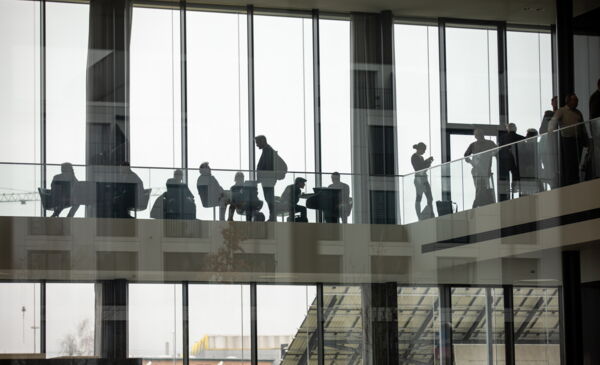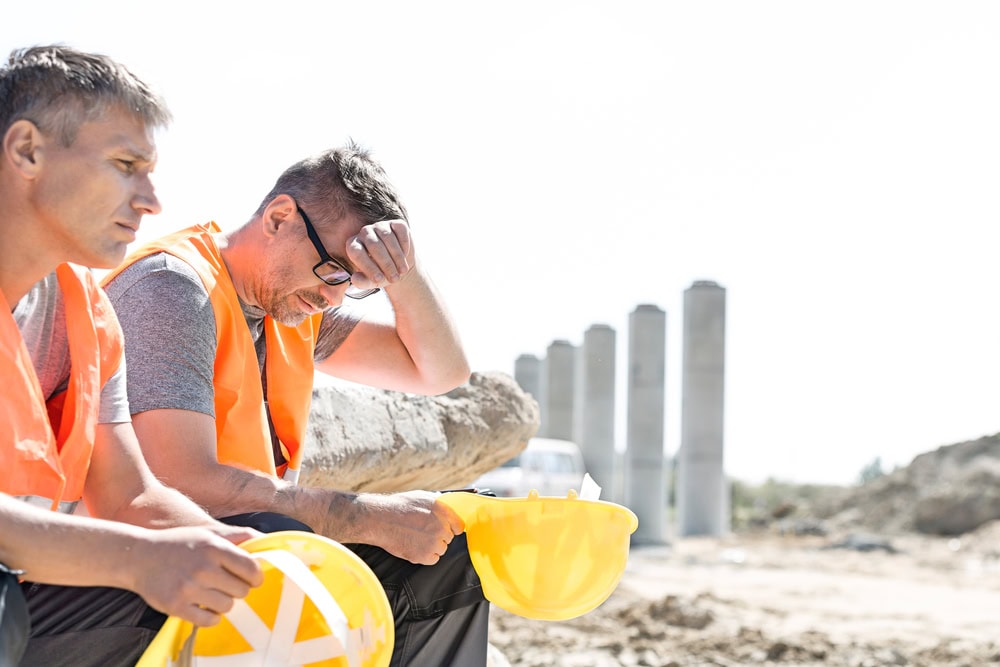Power outage: Is my company prepared?
Many companies are prepared for a power outage lasting a few hours. An outage lasting several days in the event of a blackout or cyclical shutdowns in the event of a power shortage pose a greater challenge, as not only the company itself is affected, but also its partners, its customers and critical infrastructures.
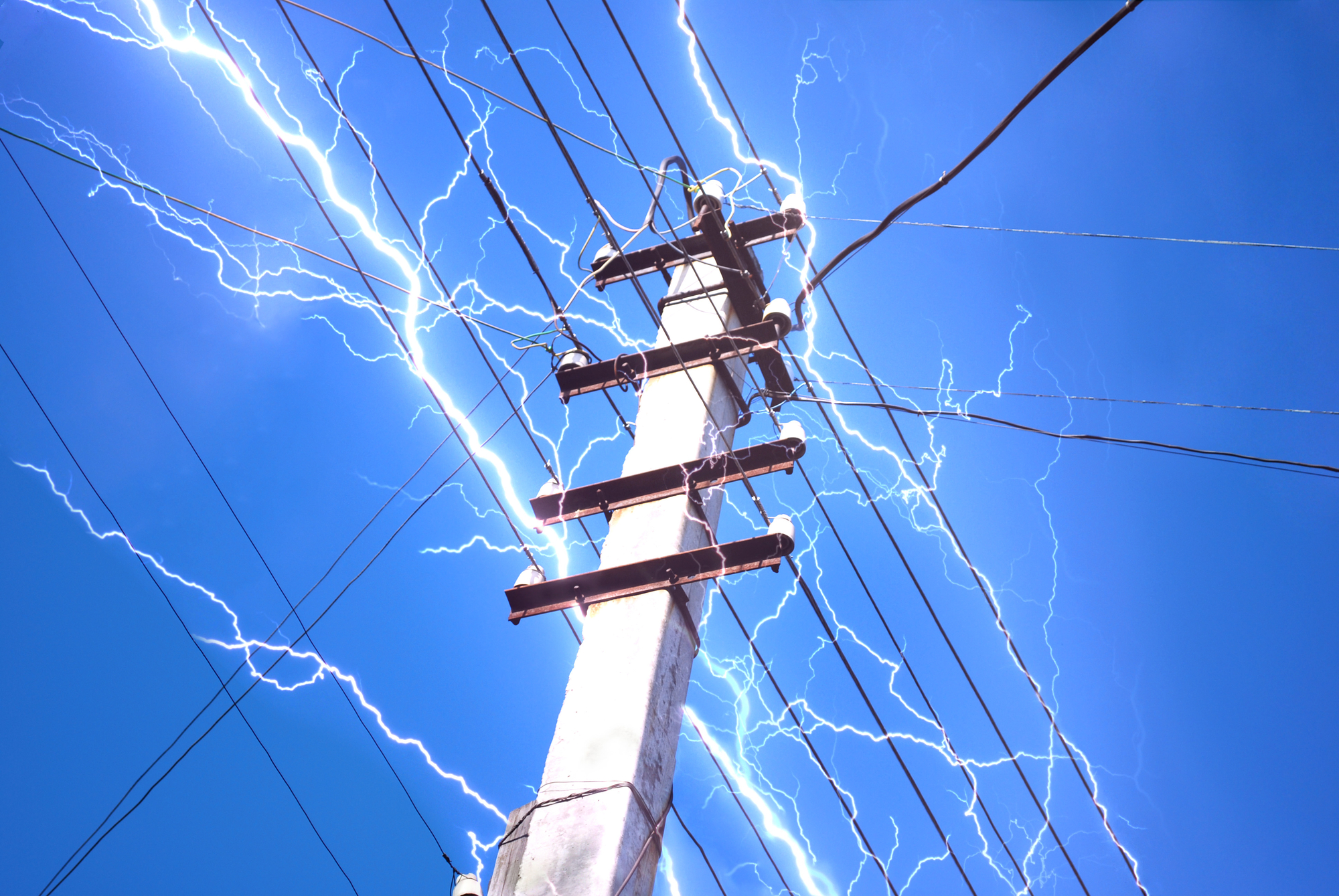
It's a horror show: the lights go out, the screens go black, streetcars and trolleybuses come to a standstill, machines stop working, emergency lighting slowly comes on.
The Federal Office for Civil Protection (FOCP) assumes that a power shortage - i.e. an undersupply of electricity for several weeks - is one of the greatest dangers for Switzerland. In the risk analyses of the FOCP, the frequency of a power shortage situation is shown as "every 30 to 100 years". The blackout of the power supply is also shown with this frequency, but with a lower monetarized damage.
Various examples from home and abroad show that the danger is real, despite the estimated probabilities of occurrence of "every 30 to 100 years":
- In 2017 and 2019, Zurich's city center each experienced a power outage in which, among other things, the main train station was dark and streetcars in the city came to a standstill.
- In the winter of 2016/2017, many nuclear power plants in France were not connected to the grid. The dry December was followed by a major cold snap in January. As a result, the storage reservoirs emptied very quickly and reached historic low levels. Only thanks to direct measures was it possible to avert an electricity shortage in Switzerland.
- In the winter of 2015/2016, an electricity shortage was only narrowly averted. The two reactors of the Beznau nuclear power plant were idle, the production of the run-of-river power plants was below average due to the dry summer, the reservoirs had a below-average filling level and the imported electricity could not be transformed to the right level.
- In December 2015, Ukraine experienced a blackout lasting several hours due to a cyberattack.
- In November 2006, there was a major power outage in Europe as two high-voltage lines in Germany were switched off for the departure of a cruise ship. As a result, several million households were without power for up to 120 minutes.
Relevant scenarios
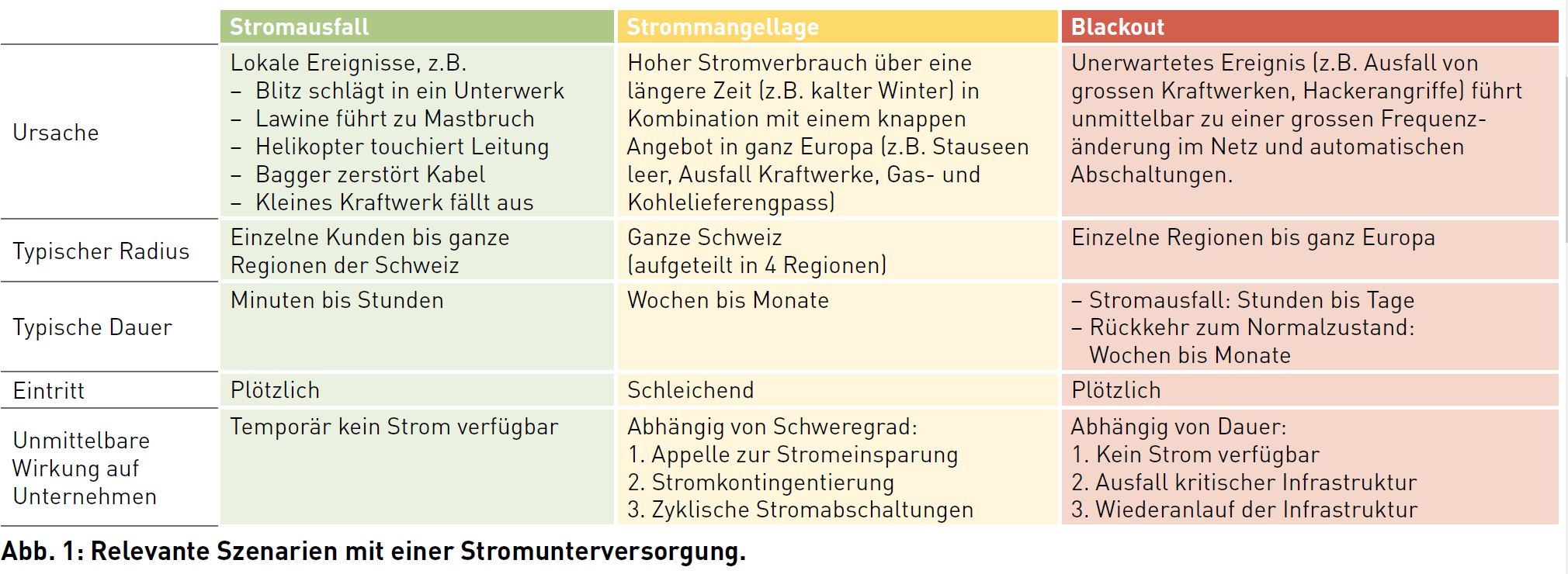
Companies can distinguish between three different scenarios (see Fig. 1) in which they would be affected by an undersupply of electricity:
- First: A power failure occurs due to a local event (e.g. when an excavator tears open a cable of the power supply during reconstruction). These power outages are regionally limited and can usually be solved by the local power supplier in a short time, at least with a temporary solution.
- Second: In an electricity shortage situation, the electricity demand cannot be covered by the electricity supply over a longer period of time. Depending on the severity of the situation, the federal government issues appeals for electricity savings, a quota system or cyclical power cuts. In the case of cyclical power cuts, two stages have been prepared by the Organization for Electricity Supply in Extraordinary Situations (Ostral) of the Association of Swiss Electricity Companies (VSE). In stage 1, a cycle of four hours of interruption and eight hours of supply is planned. In stage 2, after the four hours of interruption, only four hours of supply are planned for each of the sub-areas.
- Third: If the power supply in a network collapses completely, this is referred to as a blackout. In such a scenario, it is necessary to assume not only an immediate power failure, but also a failure of critical infrastructure and a prolonged phase of restoration to normal.
Determine precaution
With a systematic approach (see Fig. 2), companies can prepare effectively and efficiently for the three scenarios of power failure, power shortage and blackout and coordinate with partners and authorities to avert existential damage in the event of an incident. Each company must determine the relevance of the precautions for the three scenarios. The relevance can also differ according to business area or location.
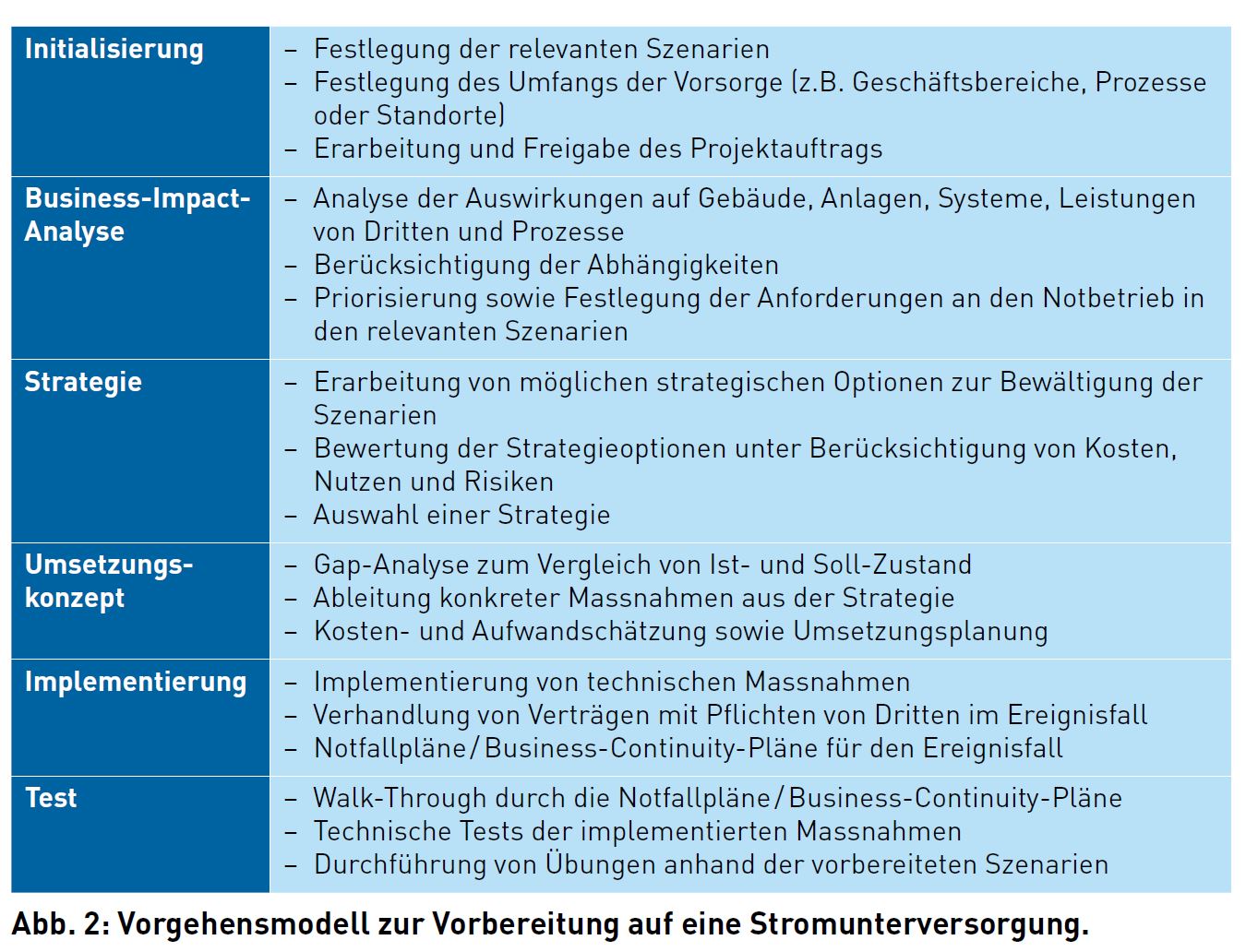
Power dependencies
Electricity has long been essential in most companies. The importance of electricity has increased much more in recent years due to increasing digitalization and automation, but also due to the promotion of electromobility.
The concrete dependence on electricity is industry and company specific. The business impact analysis must therefore identify:
- Which business processes must necessarily be continued so that no major damage occurs?
- Which of the resources used in the business processes (e.g. buildings, machines, IT systems) are absolutely dependent on electricity?
- What would be the impact on these resources and business processes in the event of cyclical power outages or power outages of varying lengths (e.g., one hour, one day, two days)? Are there alternative short-term solutions to keep processes running?
- How long may the business processes and the resources used for them be down?
- Are there processes that rely on electricity only during certain times of the day or year (e.g., heating in winter, cooling in summer)?
The following examples of typical resources in a company show how profound the dependence on electricity is within a company:
- Web portals and online stores
- IT systems
- Telephones, printers and fax machines
- Cash register systems and safes
- Lighting, ventilation and building control
- Monitoring and access protection systems
- Warehouse management (e.g. high-bay warehouses, electric forklifts, distribution systems)
- Cold storage and cabinets
- Plant and production control
- Machines with electric drive
- Laboratory and analytical equipment
- Gas stations on the company premises
In the event of a prolonged blackout, companies must also reckon with chain reactions that present them with further challenges. These can be, for example:
- Outage fixed network and mobile telephony
- Failure radio and television
- Fuel supply failure
- Failure public transport, road transport, air transport
- Failure water supply and sanitation
- Severely limited medical care
- Absence of employees (no possibility to travel, family)
Provisioning strategies
Companies can define different strategies for coping with the three scenarios of power failure, power shortage or blackout. The choice of strategy is influenced, among other things, by how time-critical the business processes are and how many locations the company has.
The following options are available as general strategies for a power outage:
- Continuation of critical business processes with uninterruptible power supply (UPS), emergency generators, battery-powered or alternative systems.
- Relocation of business activities to those sites which are still supplied with electricity.
- Temporary cessation of operation.
In preparation for a quota of electricity in the electricity shortage scenario, Ostral envisages that large consumers (annual consumption >100 MWh) who are active at several locations can register as multisite consumers. In the case of a quota of electricity, the total consumption of the company is quotaed and not the individual location. This enables a strategy in which some sites are operated normally and others are closed.
When choosing a strategy for cyclical power cuts, care must be taken to ensure that IT systems and production facilities require a certain amount of time for restarting, set-up time and cleaning, and that suppliers are also unable to deliver to the usual extent. In the case of cyclical power cuts, it must therefore be carefully examined how prioritized and reduced production can be maintained during the announced power cuts with an emergency power supply or adapted personnel deployments and inventories.
In the blackout scenario, in addition to the immediate power outage (phase 1), strategies must also be prepared for phase 2 (loss of critical infrastructure, personnel and key suppliers) and phase 3 (restoration to normal with limited supply). These strategies are company-specific and can include, for example, the topics of communication, supply of operating material stocks, transport of goods and people, water supply, wastewater disposal.
Implementation
As part of a gap analysis, the company should determine which of the strategies can be implemented with the measures already implemented and where there are still gaps. Concrete measures must be derived from the gaps, which are evaluated according to aspects of cost-effectiveness. An implementation plan is drawn up for the selected measures.
In particular, the following measures are needed during implementation:
- Implementation of technical measures that enable emergency power supply or operation with reduced power requirements.
- Development of business continuity or contingency plans describing emergency operations for the company's critical processes during a power shortage and blackout in accordance with the selected strategy.
- Establish a crisis or emergency management team to lead the management of the power shortage or blackout.
- Development of checklists and tools for employees so that they can initiate the necessary immediate measures in the event of a power failure.
- Training the organization for the relevant scenarios.
If possible, these measures should be integrated into the existing structures of business continuity management and crisis and emergency management.
Test and practice
According to the motto "Only what is tested works", preparedness for power outages, power shortages and blackouts must also be tested and practiced. With a building program of discussion-based reviews (walkthroughs, table-top exercises), technical tests and simulations, the company can quickly gain confidence that the strategies chosen and the measures implemented are effective.
Conclusion
The supply of electricity is vital for the survival of companies. Power outages, power shortages and blackouts can threaten their very existence. It is therefore of fundamental importance to think about possible exceptional scenarios at an early stage, to develop concrete strategies and measures and to test them in a detailed and structured manner. With good preparedness, companies can secure a strategic recovery advantage over their competitors.
Author
Dr. Simon Erb, Partner of the consulting firm aucoma ag, Stans







